Hello, winter — you’ve zapped my garden
Hello, winter! We’re not used to seeing you here in Central Texas. Despite predictions of a mild winter, with the warming influence of a La Niña, we’ve already had two multi-day stretches of hard freezes, with a couple of nights dropping into the upper teens.
The result? Brown, brown, brown plants. Semi-melted agaves and aloes. Tender succulents reduced to mush. (Notice the potted ‘Monterrey Frost’ squid agave looks great though!)
Considering that my garden didn’t have a single hard freeze last winter, this has come as a shock, not only to my marginally hardy plants but to my eyes. I’m not used to seeing so much brown. And I have to admit that I don’t like it.
Oh, the natives are fine, of course. They can take temperature extremes in stride. The Texas dwarf palmetto (Sabal minor) on the left still looks green and happy. So do certain exotics, like pale pavonia (Pavonia hastata) and ‘Sparkler’ sedge. But bamboo muhly (Muhlenbergia dumosa) and foxtail fern (Asparagus meyeri), both of which I rely on heavily because they thrive in dry, dappled shade and deer don’t touch them, have become as dry and bleached as straw. I can only hope they’ll come back from the roots.
It’s the same story with Mexican honeysuckle (Justicia spicigera) and variegated flax lily (Dianella tasmanica ‘Variegata’). Mushy and brown.
If you’re wondering, yes, I cut back the dianella in the front garden because I couldn’t stand its straw-like ugliness near the front door. But generally I recommend waiting on cutting back until mid-February to give roots a little protection, to avoid stimulating early growth that could get zapped by another freeze, and to give shelter to wildlife.
In the back garden, the stand of Mexican honeysuckle, usually green all winter, is blackened and sad.
Even my normally winter-hardy ‘Jaws’ agave shows some bleached-out freeze damage.
This is when yuccas really shine, like these ‘Color Guard’ yuccas. Winter weather doesn’t faze them. Let’s sing the praises of ‘Winter Gem’ boxwood too, impervious to polar vortexes. Gah, the poor bamboo muhly behind the yuccas, though.
I’m sure those of you in colder climates are finding it hard to sympathize. What can I say? Mild winters are surely our reward, here in Texas, for putting up with blistering summers, right? RIGHT??
Ah well. Spring is already stirring here in Austin, as the Carolina jessamine (Gelsemium sempervirens) shows. By mid-February new growth will be glowing green throughout the garden, and winter clean-up will begin in earnest.
This is my January post for Foliage Follow-Up. Fellow bloggers, what leafy loveliness — or ugliness — is happening in your garden this month? Please join me in giving foliage its due on the day after Bloom Day. Leave a link to your post in a comment below. I’d appreciate it if you’ll also link to my post in your own — sharing link love! If you can’t post so soon after Bloom Day, no worries. Just leave your link when you get to it. I look forward to seeing your foliage faves.
I welcome your comments; please scroll to the end of this post to leave one. If you’re reading this in a subscription email, click here to visit Digging and find the comment box at the end of each post.
_______________________
Digging Deeper: News and Upcoming Events
2/25/17: Come to my talk at the Wildflower Center. I’ll be speaking at the day-long Native Plant Society of Texas Spring Symposium at the Lady Bird Johnson Wildflower Center in Austin. My talk is called “Local Heroes: Designing with Native Plants for Water-Saving Gardens,” and it’s about creating water-wise home gardens that don’t sacrifice beauty. The symposium is open to the public. Click here for registration. I’ll be offering signed copies of my books, The Water-Saving Garden and Lawn Gone!, after my talk ($20 each; tax is included). I hope to see you there!
Get on the mailing list for Garden Spark Talks. Inspired by the idea of house concerts — performances in private homes, which support musicians and give a small audience an up-close and personal musical experience — I’m hosting a series of garden talks by design speakers out of my home. The first talk with Scott Ogden has sold out, but join the Garden Spark email list for speaker announcements delivered to your inbox; simply click this link and ask to be added.
All material © 2006-2017 by Pam Penick for Digging. Unauthorized reproduction prohibited.



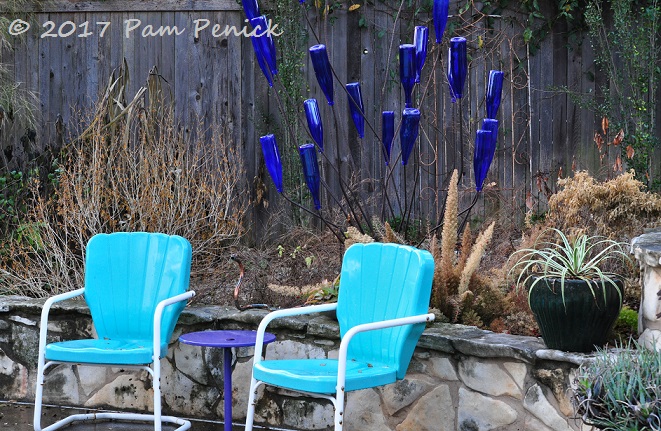
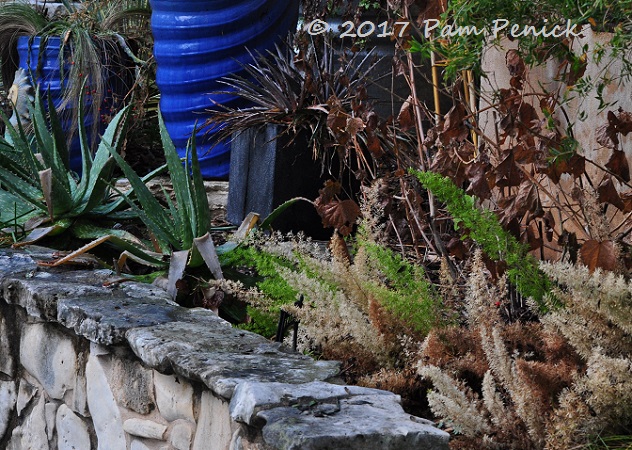
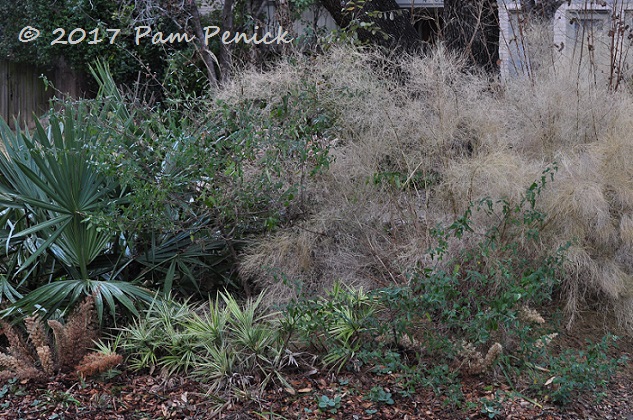
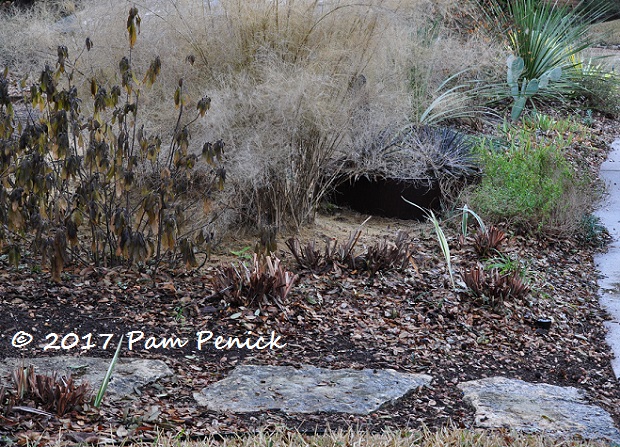
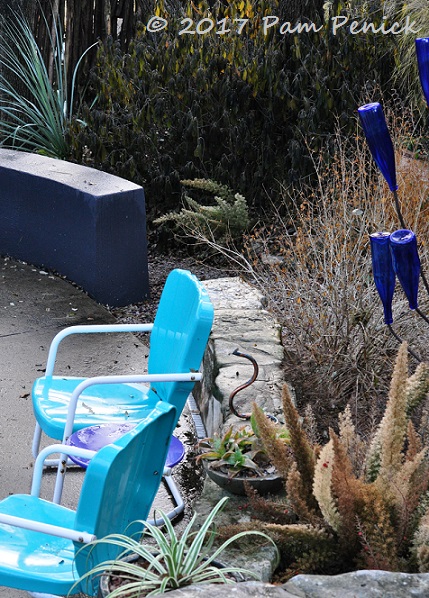
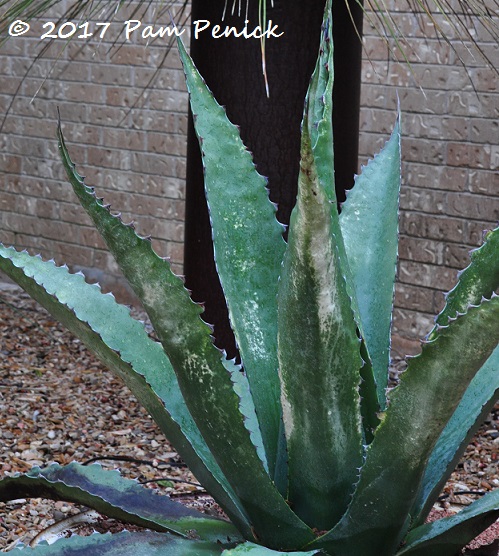
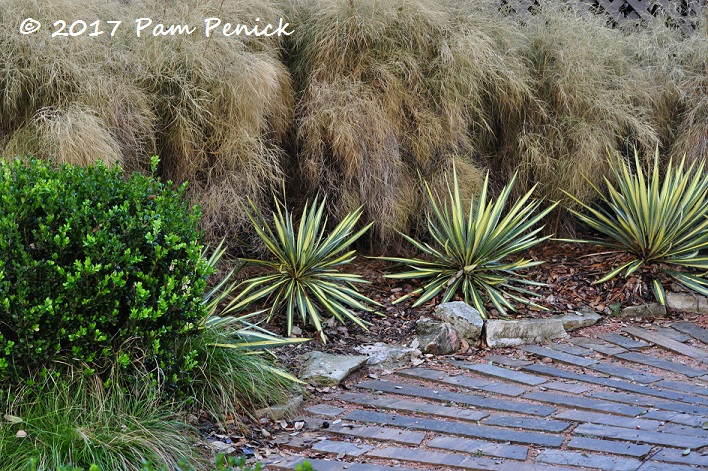
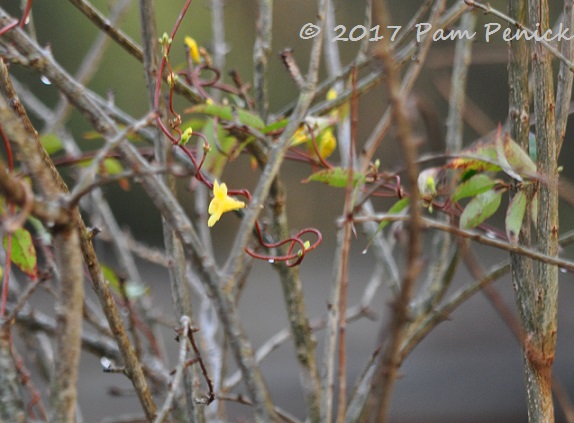
Hard freezes are tough. It is definitely sad to see plants suffer under such extreme temperature swings. As you know, winters in the SE are brown and boring. I have tried really hard the past few winters to find joy in the subdued landscape. I try to focus on the textures and seed pods. I hope your plants will make a roaring comeback in spring.
A few evergreens can make a huge difference, and you are right to look for the beauty in dried seed pods, bleached grasses, etc. I always leave my sea oats standing through the winter because they look beautiful, even when dormant. And as you point out on your recent post, the leafless season is a great time for bird watching! —Pam
In western Virginia, we can count on long, low freezing periods, with intermittent ice and snow. The Yucca ‘Color Guard’ has been the best-looking plant in the garden at this time of year for a long time now.
But its cheerful color note looks faintly ridiculous exactly because it’s all alone, so this winter I’ve been shopping for a few plants that the Yucca can “speak to” in December and January. On order: a yellow-berried possumhaw (Ilex decidua ‘Finch’s Gold’) and a pair of ‘Citronelle’ heucheras. The heucheras are probably going to be more chartreuse than yellow, but I’ve been wanting some anyway, so this is a great excuse.
Still pondering on a yellow-twig dogwood…
Good point, Nell, about how a single bright plant in winter can look lonely — or even ridiculous. Ha! I like your idea of adding a few other winter-color plants to balance things out. And I especially love those yellow-berried possumhaws. —Pam
Keep your eyes peeled for any retailers of yellow-berry possumhaw! Probably more of them down your way near the true natural range of the plant. I ordered the last one available from the only source I found, in Louisiana — so could be I’ll need to keep looking.
I have a photo of one in this post: https://www.penick.net/digging/?p=23787 — about halfway through. —Pam
Thanks so much for the link to that garden. I have a weakness for rills and circular pools, and mesh fencing. The design is so appealing that I’m pretty sure I wouldn’t have noticed that yellow-berried holly without your pointer…
Hope the blue weeping Acacia there made it through the recent cold dip. That’s a great example of something you focus on in your book, a plant that brings the look and feel of falling water to a dry garden. [Reinforced in this case by the sound and sight of actual falling water across the way.]
I hope it did too. Perhaps being in the courtyard and surrounded by the walls of the house would give it some added protection. —Pam
Beautiful garden! There is still a lot of green despite the cold weather.
I have Hellebores shoots coming up for my foliage post this month.
https://leasmenagerie.blogspot.com/2017/01/garden-bloggers-bloom-day-january-2017.html
Have a wonderful week!
Yay for new shoots! —Pam
Yep, my garden looks a lot like yours: crunchy Turk’s Cap, straw-colored lemon grass, mahogany-leafed cannas, and so forth.
I was lulled somewhat into complacency with that “mild winter forecast” but I should have known better.
Like you, my hope is some of the plants will come back from their roots. I’m pretty sure the Turk’s Caps will. The potted plants all sheltered against my privacy fence may be a different story.
Yep, the Turk’s cap will be just fine. Gotta love those tough natives! Good luck with your remodeling projects, Laura. —Pam
It has been an unusual winter here as well in the northeast. Your garden still looks wonderful despite the cold temperatures and the natives seem to be holding up just fine. I especially like the bright yellow and green foliage on your yuccas against the Wintergem Boxwood. Here is my foliage post for this month…it’s all about the evergreens! http://landscapedesignbylee.blogspot.com/2017/01/garden-bloggers-bloom-day-foliage.html
I always enjoy seeing your beautiful conifers, Lee. —Pam
I didn’t write a Foliage Followup post, because my whole garden is full to bursting with the kind of brown ugliness you lament here. Because of that, this is always my least favorite time of the year. But I did want to post a comment to commiserate.
Thanks for commiserating, Alison. 🙂 —Pam
Ah Pam, even though I live in a much colder climate, you have my sincere sympathy – it is the extremes that always challenge the garden. We have had the opposite problem here in western PA – after our normal hard freezes, we have had very warm weather, into the 60’s, and then plunge back into freezing. The plants can’t cope and I’ve been pushing plants back into the ground where they have heaved after the protective mulch blew off. More plant demise 🙁 On the other hand, new planting opportunities abound 🙂
Lynn, I’ve never lived in a place with frost heave, but I can imagine it’s very frustrating to have to replant your plants when it’s not even planting season. But I like the way you’re looking on the bright side: new planting opportunities! —Pam
Wishing you a warm turn around! What a wicked winter this has been. I’m dealing with plant demise as well…more freezing rain is in the forecast for the PNW after 2 weeks of sub-freezing temps and buckets of snow. OY!
You guys have been hammered. I hope you’re thawing out by now. —Pam
Oh, that’s hard to look at. You have my sympathies, Pam. I hope all that brown turns to green come spring. The PNW is getting hit with a bad winter, too, but it’s still within what we should expect every 5-10 years, even though most people tend to “forget” in those intervening mild years. It’s awful timing for me, with all the young plants I added in fall, but I’m still hoping for more pleasant surprises than disappointments come spring.
The snow that we’ve all been wailing about here is finally starting to melt, and should be gone by the end of tomorrow. I’m waiting to do my bloom day AND foliage follow-up posts until then. I just couldn’t bear to post more snow pictures. My last snowfall had barely melted before this current one dropped more white stuff.
I can’t believe the pictures I’m seeing from my friends in the PNW. So much snow! Our cold blasts are well within what we can see every 5 to 10 years too, but of course I tend to push our zone in the interval, knowing full well that eventually we’ll get a freeze that those tender plants won’t like. Ah well, it’s part of the adventure of gardening! —Pam
At least you realized it and know what you’re getting yourself into. I would zone push more if I didn’t have so much space to fill. I can’t afford the setbacks, yet. The snow finally melted here! So I got out and took photos. It’s a mixed bag, but this is my Foliage Follow-up: http://practicalplantgeek.blogspot.com/2017/01/from-snowy-to-soggy.html
Yikes! I didn’t think anything could knock a foxtail fern out. I hope that at least some of the brown plants comeback from their roots for you when the temperatures warm. I’m taking all El Nina/La Nina predictions with a grain of salt from here on out after last year’s El Nino failed to bring us much of any rain and this year’s La Nina (thankfully) has brought us more rain than we’ve had in 6 years.
I have photos for a foliage follow-up post in my camera and hope to get that together later this week.
I’ve been cheering over all the rain CA is getting this winter. It must be a huge relief to you. Hope it breaks your drought! —Pam
The drought’s diminished but still far from over; however, now we have hope! Here’s a link to my belated Foliage Follow-up post: https://krispgarden.blogspot.com/2017/01/foliage-follow-up-wednesday-vignette.html
Thanks for this post! This is my first winter, at our new home, here in San Antonio. Talk about brown! I am new to gardening in this lovely climate…may I ask what to do with my brown Mexican Honeysuckle and Plumbago? Trim it? How low?
I have enjoyed your blog/website so much! Thank you for inspiring me to create my garden.
Welcome to Central Texas gardening, Lynnette, and thanks for reading Digging! As to your browned Mexican honeysuckle and plumbago, I suggest cutting them back in mid-February. Valentine’s Day is an easy way to remember when to cut back perennials each year. I’d cut the honeysuckle back to about 12 inches and the plumbago back to about 6 inches. —Pam
Thank you so much! I look forwad to continued learning.
PAM: you are absolutely right: we should suffer EITHER miserable summer heat OR plant-murdering freezes, but definitely not BOTH!!!!
thanks for posting this, as right now, my misery is loving the company…our garden looks quite “sepia” and is full of gooey, deflated cacti, smelly rotting remains of once-beautiful succulents, and yes, freeze-dried foxtail ferns…every morning I find something else has succumbed, and today, when my humongous, ever-hardy ming ferns suddenly dropped all their tiny “feathers” just like the charlie brown Christmas tree, i simply could not stand it anymore and began a probably-too-early clean-up…an hour later at least one cactus had been put out of its misery and my once-glorious macho ferns had been given buzzcuts, but for this effort what was my reward? THREE MOSQUITO BITES!!!!!!! AGGGH! SALT IN WOUND!!!! frozen plants as far as the eye can see but the bloodsuckers can still frolic away??!!? where is the gardening justice of it all?!
I laughed out loud while reading your comment, Linda, and then had to read it out loud to my husband. Just this evening, a mosquito buzzed us over dinner as we sat at the table. Indoors! I can report with satisfaction that it did not survive. —Pam
Hoping the melted aloe and other succulents may be alive at the root. Didn’t think those
would suffer so badly.
My spring color is the only relief in the brown world at the moment. Have to coddle that a bit, but it’s worth it.
Nurture the green where you can find it in winter! —Pam
OK, so I cheated a little and posted about my indoor plants this month: https://plantpostings.blogspot.com/2017/01/january-blooms-and-foliage.html. Hope that’s OK. 😉 Even though I live in a northern climate, I still empathize. I don’t like the mush effect or the browns/grays of winter, either. Snow helps a little, but that gets old, too. I hope most of your plants will come back lush and full next month. Thanks for hosting Foliage Follow-Up!
Cheating? No such thing, Beth. Post whatever foliage is making you happy (or, in my case, unhappy)! As always, thanks for joining in. —Pam
Same here Pam.. and you know what’s really gross?? The smell of mushy dead society garlic in the stock tank pond. We’ve had some plumbing problems so I thought it was a sewage smell in the backyard… nope! Definitely replacing it with that dwarf papyrus for my marginal this year.
That sure sounds, um, fragrant, Laurin. I actually didn’t know one could grow society garlic in a pond, so I’m intrigued! Based on your description, however, I don’t think I’ll be trying it myself. 🙂 —Pam
If it wasn’t for my boxwoods and mountain laurel I think I would go with plastic plants! I do have society garlic that always bounces back after a freeze but what about flax lily and sago palms? I noticed you said cut back after Valentine’s Day. Should I do anything else to encourage a comeback?
Your sagos will probably releaf anew in the spring. The flax lilies are iffier, depending on how established they were, how cold it got, and how much protection they had. Hold off on doing anything now and prune back the dead leaves in mid-February. Then be patient for a couple of months to see what comes back with warmer temps.
Take what you’ve learned about hardiness in your microclimate and plant accordingly — or not, if you’re a risk-taker! — next time. I plant lots of natives and winter-dependable non-natives, but I do use a number of tender plants too, just because I love them and they’re so well suited to my dry, shady, deer-infested conditions — most of the time. —Pam
I’m kind of surprised you don’t have a better idea of what’s gonna see damage in a freeze there, it can’t be that much of a surprise that zone 9 plants will see some damage in a freeze. Or do you get freezes so infrequently, or dont know how cold tolerant the plants will be? Of course there are opposite approaches; leave the plants to fend for themselves, or cover/protect when a freeze is predicted, or minimize the frost sensitive plantings.
We were VERY lucky we didn’t get the bad freeze here in the Bay Area the beginning of January which was forecast, we got cloud cover and rain instead. I would have been worn out moving/covering all tender plants here, and some of the larger trees and palms are simply too large to protect. Periodic freezes are rare here this close to the San Francisco Bay, so one gets lulled into complacency.
Some freeze lessons I’ve taken to heart over the years, is group sensitive plants together, making them easier to protect as a group, and take advantage of overhead cover of trees, roof overhangs, walls and pavement that can absorb and retaliate heat. Also, I rarely plant frost sensitive big expensive specimen trees or palms anymore in client’s gardens, not worth the anxiety.
We all have different takes on zone pushing, and I’m sure we also all get spoiled by the mild winters. I’m hoping that all this rain finally doesn’t cause major losses with the increased amount of desert species I’ve been using, some even from West Texas! I tried to plan for it, by only planting with amended soils on berms or slopes, but sustained cool temps and wet soil can’t really be counteracted if it goes on to long.
Looks like most plants in your own garden should bounce back well. But maybe throw a large cardboard box over the Foxtail Asparagus in future to minimize damage. Those Muhlenbergia dumosa should bounce back fast, we’ve never gotten cold enough here to freeze them. How low did you go?
Sure, I knew that bamboo muhly and foxtail fern and certain other plants could be damaged in an extreme cold spell. That’s what zone pushing means. But in the 8 years I’ve gardened at this house, I haven’t seen a double whammy of freezes into the low 20s and upper teens like we’ve had this winter. Last year, those of us in the warmest parts of Austin didn’t see a hard freeze at all. You’re right that covering plants can help, but I have way too many foxtail ferns in my 1/3-acre yard to cover, and our high Texas winds blew off many of the covers I did use.
Even if you know you’re zone pushing, it’s still a shock when you finally get zapped. Will it stop me? No way. Well, only if freezes like this become the new normal. Stranger things have happened! —Pam